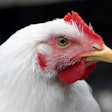 litterfiredfurnacesttesting.jpg
litterfiredfurnacesttesting.jpg
Litter-fired furnace on Brisco Farm, Anderson, Mo.
One group in Missouri and another group in Arkansas are working to develop practical litter-fired furnaces for use heating poultry houses. The state of Missouri has teamed up with a few poultry growers in that state to test the feasibility of using poultry litter as a fuel. Jo Brisco, Anderson, Mo., who raises turkeys under contract with Cargill, is one of the growers participating in the test program. The furnace Brisco is testing was designed to burn 1 ton of litter per day and produce 500,000 BTUs of heat. It works in a similar manner to an outdoor wood furnace for a home. The furnace does not have an ignition system, Brisco said that he uses a little bit of charcoal and lighter fluid to get the fire started. Once the fire is started, the furnace has electronic controls, fans and motors to automatically adjust the damper and drawn air into the stove. High temperatures, up to 1,500 F, insure that the litter burns cleanly.
Located outside the brooder house, the furnace uses outside air for combustion and it exhausts outside as well. The furnace heats air which is blown into the center of the turkey brooder house. Propane stoves, and other heating devices that combust inside the poultry house, add carbon dioxide and water vapor to the house air. Burning fuel and exhausting outside of the house makes it easier to keep the litter dry in cold weather and reduces the need for ventilation.
Brisco said that he uses the litter-fired furnace in cold weather months to provide heat in the brooder house, but he still must use the brooder stoves to get heat on the backs of the turkeys, the way poults like it. This type of hot-air furnace may have more benefit for broiler growers, because chicks do not require brooder stoves to the same extent that poults do. The prototype furnace that Brisco is using cost around $21,000, and Brisco estimates that it would pay for itself in about three years the way he is using it now. He said that if the stove was set up to heat water instead of air, it might be possible to heat the finisher houses for the first few weeks after he moves birds into these houses, in addition to heating the brooder house.
Brisco said that the furnace has worked relatively well, and that it will burn just about anything. However, he said that he has had some problems getting the litter to feed into the furnace automatically. Initially the unit had an auger, but that didn’t work, and he is hopeful that the feed system can be perfected. The furnace hopper is filled with litter using a front end loader and Brisco said that litter from the either brooder house or the finisher houses can be burned.
Tom Costello, associate professor of biological and agricultural engineering, University of Arkansas is working with Lynndale Systems Inc., a furnace manufacturer in Harrison, Ark., to test a litter-fired furnace on the poultry research farm at the University. Lynndale’s litter furnace uses propane to ignite the litter and it has an auger to feed litter into the furnace.
Based on testing done to date, Costello reports that using the litter furnace has reduced gas usage by 80 percent. A typical broiler house would produce around 125 tons of litter per year and this should be enough to heat the house for an entire year in most major broiler producing areas of the USA. Costello said that a typical chicken house would need two to four tractor bucket loads of litter per day, depending on the temperature outside. A farmer could use about one ton of litter per day for space heating under typical winter conditions. "Obviously, farms in Minnesota would consume more litter than farms in Arkansas or Georgia," he said.
After initial ignition by a propane burner, the prototype maintains combustion with 100-percent raw litter, so it does not need additional materials for fuel. The furnace is connected to a thermostat in the chicken house that senses when heat is needed and automatically switches the furnace to deliver heated air via a duct.
Costello said tests have demonstrated the energy content of litter in the range of 4,000 to 5,000 British thermal units per pound of litter. He said the furnace prototype needs design improvements to create a commercial product that is economically feasible. "Increased efficiency and heat output are needed, but these improvements can be reasonably expected from the manufacturer," he said.
Bob Dodson, Lynndale's chief executive officer and president, said that his company expects to produce retail units of the furnace by the end of 2007.













